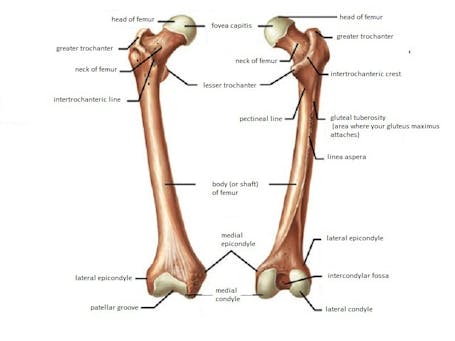
femur info...
The femur bone in a horse, often referred to as the "thigh bone," is the largest and longest bone in its body. It is similar in structure and function to the femur bone in humans and other mammals. The femur plays a crucial role in supporting the horse's body weight and facilitating its movement.
Here are some key characteristics and facts about a horse's femur bone:
- Size and Length:
The femur in a horse is relatively large and can measure over two feet in length, depending on the size and breed of the horse. It is thicker at the top and tapers towards the bottom.
- Articulation:
The femur articulates with the hip bone (pelvis) at the proximal end and the tibia and fibula bones of the lower leg at the distal end. These articulations enable the horse to bend and extend its hind legs, allowing for various movements like walking, trotting, cantering, and galloping.
- Muscles Attachment:
Numerous muscles in the horse's hindquarters attach to the femur, including the powerful gluteal muscles, quadriceps, hamstrings, and adductors. These muscles are responsible for generating the force needed for locomotion.
- Weight-Bearing:
The femur bears a significant portion of the horse's body weight, particularly when the horse is in motion. It absorbs and distributes the impact forces generated during movement, helping to protect the joints and bones in the leg.
- Structure:
Like all long bones, the femur has a shaft (diaphysis) and two ends (proximal and distal epiphyses). The diaphysis is strong and cylindrical, providing support, while the epiphyses are responsible for joint articulation.
- Blood Supply:
The femur, like other bones, has a blood supply that helps nourish the bone tissue and repair any damage. Blood vessels and nerves run through the bone to ensure proper functioning.
- Growth and Development:
In young horses, the femur, like other bones, is not fully developed and undergoes a growth process. As the horse matures, the femur reaches its full size and strength.
- Vulnerability:
While the femur is a robust bone, it is not immune to injuries, particularly in the event of traumatic accidents, such as fractures or breaks. Such injuries can be serious and may require veterinary intervention.
Understanding the anatomy and function of a horse's femur is essential for horse owners, veterinarians, and equine professionals to provide proper care, diagnose injuries, and promote the overall health and well-being of these magnificent animals.




